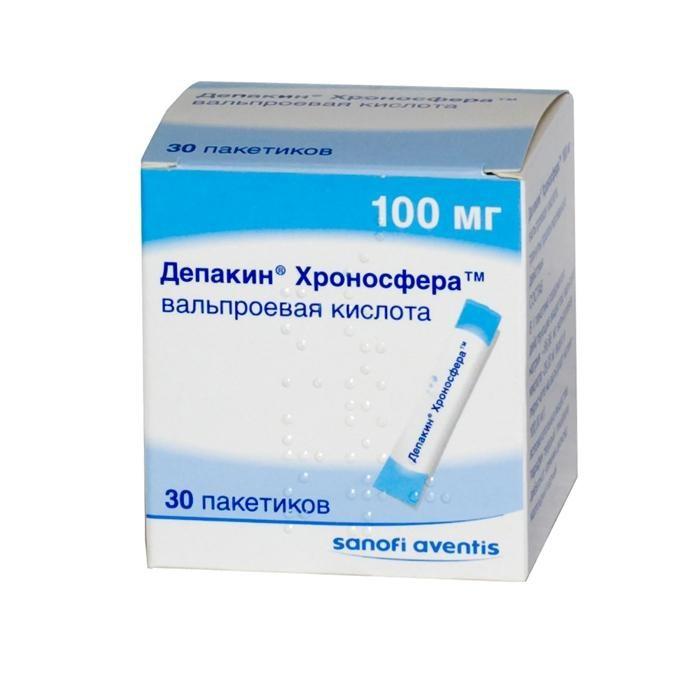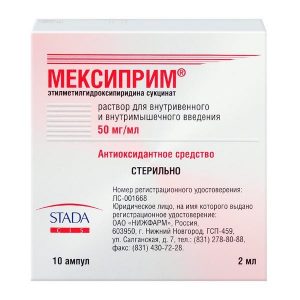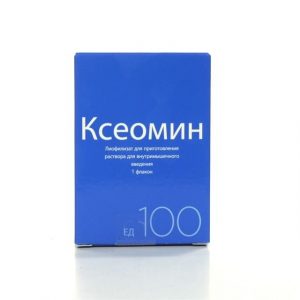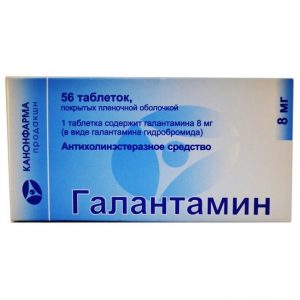Description
Latin name
Depakine chronosphere
Release form
Sustained-release granules of almost white or slightly yellowish color, waxy, easily loose, without agglomerate formation.
Packaging
Three-layer sachets (30) – packs of cardboard.
Pharmacological action
Antiepileptic drug, has a central muscle relaxant and sedative effect.
It exhibits antiepileptic activity in various types of epilepsy. The main mechanism of action, apparently, is associated with the action of valproic acid on the GABA-ergic system: it increases the GABA content in the central nervous system and activates GABA-ergic transmission.
Depakin ® Chronosphere ¢ is a granule of prolonged action, providing more uniform drug concentrations throughout the day.
Pharmacokinetics
Absorption
The oral bioavailability of valproic acid is close to 100%. Eating does not affect the pharmacokinetic profile. Cmax of the drug in plasma is reached approximately 7 hours after ingestion.
Compared to the enteric-coated dosage form, the equivalent doses of Depakin ® Chronosphere ¢ are characterized by longer absorption, identical bioavailability, more linear correlation between doses and plasma concentration of valproic acid (total concentration and concentration of the free fraction). In addition, Cmax and Cmax of the free valproic acid fraction in plasma are lower (a decrease of about 25%). but there is a relatively more stable phase of the plateau of plasma concentrations from 4 to 14 hours after administration, the magnitude of fluctuations in plasma concentrations when taking Depakin ® Chronosphere ¢ compared to the enteric-coated dosage form is halved, as a result of which valproic acid is more evenly distributed in tissues during the day.
With the course of taking the drug Css valproic acid in the blood serum is achieved within 3-14 days.
Serum valproic acid concentrations of 40-100 mg / L (300-700 μmol / L) are usually effective (determined before the first dose of the drug is taken during the day) With serum concentrations of valproic acid above 100 mg / L, side effects are expected to increase up to before the development of intoxication.
The distribution of
Vd depends on age and is usually 0.13-0.23 l / kg body weight, in young people 0.13-0.19 l / kg body weight. Due to the decrease in the magnitude of fluctuations in plasma concentrations when taking Depakin ® Chronosphere ¢, valproic acid is more evenly distributed in the tissues during the day compared to the immediate-release valproic acid dosage form.
The binding of valproic acid to plasma proteins (mainly to albumin) is high (90-95%), dose-dependent and saturable. Valproic acid penetrates into the cerebrospinal fluid and into the brain. The concentration of valproic acid in cerebrospinal fluid is 10% of the corresponding concentration in the blood serum, that is, it is close to the concentration of the free fraction of valproic acid in the blood serum.
Valproic acid passes into breast milk of nursing mothers. In a state of achieving serum valproic acid Css, its concentration in breast milk is up to 10% of its concentration in serum.
Metabolism
Valproic acid metabolism is carried out in the liver by glucuronidation, as well as beta, omega, and omega-1 oxidation. Over 20 metabolites have been identified, metabolites after omega-oxidation have a hepatotoxic effect.
Valproic acid does not have an inducing effect on enzymes included in the metabolic system of cytochrome P450: unlike most other antiepileptic drugs, valproic acid does not affect the degree of both its own metabolism and the degree of metabolism of other substances, such as estrogens, progestogens and indirect anticoagulants.
Excretion of
Valproic acid is predominantly excreted by the kidneys after conjugation with glucuronic acid and beta oxidation.
When using valproic acid in monotherapy, its T1 / 2 is 12-17 hours. When combined with antiepileptic drugs that induce microsomal liver enzymes (such as primidone, phenytoin, phenobarbital and carbamazepine), the plasma clearance of valproic acid increases, and T1 / 2 the degree of their change depends on the degree of induction of microsomal liver enzymes by other antiepileptic drugs. T1 / 2 in children older than 2 months is close to that in adults.
Pharmacokinetics in special clinical cases
In elderly patients, patients with renal and hepatic insufficiency, binding to plasma proteins is reduced.
In severe renal failure, the concentration of the free (therapeutically active) fraction of valproic acid may increase to 8.5-20%.
With hypoproteinemia, the total concentration of valproic acid (free + fraction bound to blood plasma proteins) may not change, butit may decrease due to an increase in the metabolism of the free (non-protein bound blood plasma) fraction of valproic acid.
In patients with liver disease, valproic acid T1 / 2 increases.
In case of overdose, an increase in T1 / 2 up to 30 hours was observed. Only the free fraction of valproic acid in the blood (510%) undergoes hemodialysis.
Pharmacokinetics during pregnancy
With an increase in Vd of valproic acid in the third trimester of pregnancy, its renal and hepatic clearance increase. At the same time, despite taking the drug in a constant dose, a decrease in serum concentrations of valproic acid is possible. In addition, during pregnancy, the relationship of valproic acid with plasma proteins may change, which can lead to an increase in the serum content of the free (therapeutically active) fraction of valproic acid.
Indications
In adults (as monotherapy or in combination with other antiepileptic drugs): for the treatment of generalized epileptic seizures: clonic, tonic, tonic-clonic, absences, myoclonic, atonic Lennox-Gastaut syndrome
for the treatment of partial epileptic seizures: partial seizures with or without secondary generalization
treatment and prevention of bipolar affective disorders.
In infants (starting at 6 months of age) and children (as monotherapy or in combination with other antiepileptic drugs): for the treatment of generalized epileptic seizures: clonic, tonic, tonic-clonic, absences, myoclonic, atonic Lennox-Gastaut syndrome
for the treatment of partial epileptic seizures: partial seizures with or without secondary generalization
prophylaxis of seizures at high temperature, when such prophylaxis is necessary.
Contraindications
acute hepatitis
chronic hepatitis
severe liver disease (especially drug hepatitis) in the history of the patient and his close blood relatives
severe liver damage with fatal outcome in the use of valproic acid in patients with close blood or liver function glands
hepatic porphyria
hemorrhagic diathesis, thrombocytopenia
combination with mefloquine
combinations with St. John’s wort perforated
children under 6 months of age
hypersensitivity to sodium valproate, valproic acid, semisodium valproate, valpromide, or to any of the components of the drug.
With caution
for liver and pancreas diseases in the anamnesis of
during pregnancy
for congenital fermentopathies
with inhibition of bone marrow hematopoiesis (leukopenia, thrombocytopenia, anemia) drugs because of the increased risk of liver damage
while taking drugs that provoke convulsive seizures or lower the threshold of convulsive readiness, so them as tricyclic antidepressants, selective serotonin reuptake inhibitors, phenothiazine derivatives, butyrophenone derivatives, chloroquine, bupropion, tramadol (risk of convulsive seizures)
while taking antipsychotics, MAO inhibitors, antidepressants, benzodiazepines (the possibility of potentiating their effects)
while taking phenobarbital, primidine, phenytoin, lamotrigine, zidovudine, felbamate, acetylsalicylic acid, indirect anticoagulants, cimetidine, erythromycin, carbapenemine, communication with blood plasma proteins, a change in plasma concentrations of either these drugs and / or valproic acid)
is possible with the simultaneous use of carbamazepine (risk of potentiation of the toxic effects of carbamazepine and a decrease in the plasma concentration of valproic acid)
with the simultaneous use of topiramate (risk of developing encephalopathy).
Use in case of impaired liver function
The drug is contraindicated in acute hepatitis, chronic hepatitis, in cases of severe hepatitis in the patient or in his family history, especially caused by drugs, with severe violations of the liver.
Use in cases of impaired renal function
Use the drug with caution in case of renal failure.
Use in children
Average daily dose for children, incl. breast (starting from 6 months of life) – 30 mg / kg.
Use during pregnancy and lactation
During pregnancy, the development of generalized tonic-clonic epileptic seizures, epileptic status with the development of hypoxia can be a risk factor for death for both the mother and the fetus.
Teratogenic effects of valproic acid have been shown in experimental studies of reproductive toxicity in mice, rats, and rabbits.
Available clinical data confirm that in children born to mothers with epilepsy who received valproic acid, there is an increased frequency of occurrence of intrauterine developmental disorders of varying severity (neural tube malformations craniofacial deformities malformations of the extremities, cardiovascular system and also multiple fetal malformations affecting different organ systems) compared with the frequency of their occurrence when pregnant women take some other rotivoepilepticheskih preparations.
Data from a meta-analysis that included register and cohort studies showed that the incidence of congenital malformations in children born to mothers who received valproic acid as a monotherapy during pregnancy was 10.73%. Available data indicate a dose dependence of the adverse effects of valproic acid on the fetus.
Based on available data, a causal relationship exists between the intrauterine exposure to valproic acid and the risk of developmental delay, in particular, a decrease in verbal IQ in children born to mothers with epilepsy who took valproic acid. Delayed development is often combined with malformations and phenomena of dysmorphism. However, in cases of developmental delay in such children, it is difficult to establish a causal relationship with valproic acid intake due to the possibility of simultaneous exposure to other factors, such as low intelligence of the mother or both parents, genetic, social factors, environmental factors, insufficient treatment effectiveness, aimed at preventing maternal epileptic seizures during pregnancy.
It has also been reported on the development of various autistic disorders in children exposed to intrauterine exposure to valproic acid.
Both monotherapy with valproic acid and combination therapy with valproic acid are associated with an unfavorable outcome of pregnancy, but according to reports, combination antiepileptic therapy including valproic acid is associated with a higher risk of an unfavorable outcome of pregnancy compared with monotherapy with valproic acid (t. E. The risk of developing disorders in the fetus is less with the use of valproic acid as monotherapy).
Risk factors for fetal malformations are: a dose of more than 1000 mg / day (but a lower dose does not exclude this risk) and a combination of valproic acid with other anticonvulsants.
In connection with the foregoing, Depakin ® Chronosphere ² Ñ should not be used during pregnancy and in women of childbearing age unless absolutely necessary. Its use is possible, for example, in situations where other antiepileptic drugs are ineffective or the patient does not tolerate them.
The question of whether Depakin ® Chronosphere ² Ñ is to be used or whether to stop using it should be resolved before the use of the drug or reconsidered if a woman receiving Depakin ® Chronosphere ² Ñ is planning a pregnancy.
Women of childbearing age should use effective methods of contraception during treatment with Depakin ® Chronosphere ² Ñ. Women of childbearing age should be informed about the risks and benefits of using valproic acid during pregnancy.
Pregnancy should be ruled out before prescribing the drug.
If a woman is planning a pregnancy or is diagnosed with pregnancy, then the need for valproic acid treatment should be reassessed depending on the indications: if bipolar disorder is indicated, consideration should be given to discontinuing treatment with valproic acid
if epilepsy is indicated, the question of whether valproic acid treatment should be continued or canceled after reassessment of the ratio of benefits and risks.
If, after reassessing the ratio of benefit and risk, a decision has been made to continue treatment with Depakin ® Chronosphere ² Ñ during pregnancy, it is recommended to use it in a minimum effective daily dose, divided into several techniques. It should be noted that during pregnancy, the use of sustained release dosage forms is preferred.
Before pregnancy, folic acid (at a dose of 5 mg / day) should be added to antiepileptic treatment to reduce the risk of neural tube malformations.
Continuous special prenatal monitoring should be performed to identify possible malformations of the neural tube or other fetal malformations.
The development of isolated cases of hemorrhagic syndrome of newborns whose mothers took valproic acid during pregnancy was reported. This hemorrhagic syndrome is associated with thrombocytopenia, hypofibrinogenemia and / or a decrease in the content of blood coagulation factors. Fatal development of afibrinogenemia has also been reported. This hemorrhagic syndrome should be distinguished from vitamin K deficiency caused by phenobarbital and other inducers of microsomal liver enzymes.
Therefore, in newborns born to mothers who received valproic acid during pregnancy, it is necessary to determine the number of platelets in the blood, the plasma concentration of fibrinogen, blood coagulation factors and a coagulogram.
Cases of hypoglycemia have been reported in newborns whose mothers took valproic acid in the third trimester of pregnancy.
Cases of hypothyroidism have been reported in newborns whose mothers took valproic acid during pregnancy.
Excretion of valproic acid with breast milk is low, its concentration in breast milk is 1-10% of its concentration in plasma. Based on the literature and little clinical experience, with monotherapy with Depakin ® Chronosphere ² Ñ, you can plan breastfeeding, but you should take into account the profile of side effects of the drug, especially the hematological disorders caused by it.
Fertility
In men, valproic acid can reduce sperm motility and cause male infertility. In addition, due to the possibility of the development of undesirable effects from the endocrine system and genitals in women (such as dysmenorrhea, amenorrhea, polycystic ovaries, hyperandrogenism), a decrease in fertility in women is possible.
Composition
1 pack.
sodium valproate 66.66 mg
valproic acid 29.03 mg
in terms of sodium valproate 100 mg
Excipients: paraffin solid – 101.26 mg, glycerol dibehenate – 106.05 mg, silica colloidal aqueous *.
* is added by spraying after the melt is cooled and expressed as a percentage of the amount of four other components: 0.7% (approximate amount absorbed on the granules: 0.56%).
Dosage and Administration
Depakin ® Chronosphere ¢ is a dosage form that is especially suitable for treating children (if they can swallow soft foods) or adults with difficulty swallowing.
Depakin ® Chronosphere ¢ is a granule of prolonged action, providing a more uniform concentration of valproic acid in the blood and, accordingly, more uniform throughout the day its distribution in the tissues.
Bipolar Affective Disorders
Dose should be selected and monitored by the attending physician individually. The daily dose should be established taking into account the age and body weight of the patient. The recommended starting dose is 20 mg (in terms of sodium valproate) per kg of body weight. The dose should be as quickly as possible increased to the minimum dose providing the desired therapeutic effect.
The recommended maintenance dose for the treatment of bipolar disorders is between 1000 mg and 2000 mg (in terms of sodium valproate) per day. The dose should be selected in accordance with the individual clinical response of the patient. For prophylaxis of manic conditions, an individually selected minimum clinically effective dose should be used.
Epilepsy
In monotherapy, the initial daily dose is usually 5-10 mg (in terms of sodium valproate) per kg of body weight, then it is increased by 5 mg / kg every 4-7 until the optimal dose can be avoided to prevent the occurrence of epilepsy attacks.
Average daily dose: for children (up to 14 years old) – 30 mg / kg body weight
for adolescents 14-18 years old – 25 mg / kg body weight
for adults and elderly patients (body weight from 60 kg and above) – 20 mg / kg body weight.
Therefore, the daily doses below are recommended.
Patient age Body weight Average daily dose *
Infants 6 to 12 months old About 7.5-10 kg 150-300 mg
Children 1 to 3 years old About 10-15 kg 300-450 mg
Children 3 to 6 years old About 15-25 kg 450- 750 mg
Children from 7 to 14 years old About 25-40 kg 750-1200 mg
Adolescents from 14 years old About 40-60 kg 1000-1500 mg
Adults From 60 kg and above 1200-2100 mg
* dose based on the number of milligrams of sodium valproate
Average daily the dose may be increased under the control of the concentration of valproic acid in the blood.
In some cases, the full therapeutic effect of valproic acid does not appear immediately, but develops within 4-6 weeks. Therefore, you should not increase the daily dose above the recommended average daily dose earlier than this period.
Although the daily dose is determined according to the age and body weight of the patient, a wide range of individual sensitivity to valproic acid should be taken into account.
A clear correlation between the daily dose, the concentration of valproic acid in the blood serum and the therapeutic effect has not been established. Therefore, the optimal dose should be selected mainly based on the clinical response.
Determination of the concentration of valproic acid in blood serum can complement clinical observation if epilepsy is not controlled or if side effects are suspected. Dosages that provide serum concentrations of valproic acid of 40-100 mg / L (300-700 μmol / L) are usually effective. If it is reasonably necessary to achieve higher concentrations in blood serum, the ratio of the expected benefit and the risk of side effects, especially dose-dependent, should be carefully weighed, because at serum concentrations of valproic acid above 100 mg / l, an increase in side effects is expected until the development of intoxication. Therefore, the serum concentration determined before taking the first dose per day should not exceed 100 mg / l.
When switching from Depakin ® immediate release or delayed release dosage forms that have well controlled epilepsy to Depakin ® Chronosphere ¢, it is recommended that the same daily dose be maintained.
For patients who have previously taken antiepileptic drugs, the transfer to the administration of Depakin ® Chronosphere ¢ should be carried out gradually, reaching the optimal dose of the drug in about 2 weeks. In this case, the dose of the previously taken antiepileptic drug, especially phenobarbital, is immediately reduced. If a previously taken antiepileptic drug is canceled, then its cancellation should be carried out gradually.
If necessary, a combination of valproic acid with other antiepileptic drugs should be added gradually.
Since other antiepileptic drugs can reversibly induce liver microsomal enzymes, monitor the concentration of valproic acid in the blood for 4-6 weeks after taking the last dose of these antiepileptic drugs and, if necessary (as the metabolic inducing effect of these drugs decreases), reduce the daily dose of the drug Depakin ® Chronosphere ¢.
Although elderly patients have changes in the pharmacokinetics of valproic acid, they have limited clinical relevance and the dose of valproic acid in elderly patients should be adjusted to achieve control over epilepsy seizures.
In patients with renal failure and / or hypoproteinemia, the possibility of increasing the concentration of the free (therapeutically active) valproic acid fraction in the blood serum should be considered, and if necessary, reduce the dose of valproic acid, focusing on the clinical picture rather than on the dose selection the total content of valproic acid in the blood serum (the free fraction and the fraction associated with the blood plasma proteins) to avoid possible errors in the selection of the dose.
Dosing
The drug is taken orally.
Depakin ® Chronosphere ¢ 100 mg sachets are used only in children and infants.
Depakin ® Chronosphere ¢ 1000 mg sachets are used only in adults.
The daily dose is recommended to be taken in 1 or 2 doses, preferably during meals. Application in 1 dose is possible with well-controlled epilepsy.
Depakin ® Chronosphere ¢ should be placed on the surface of soft food or drink, cold or at room temperature (yogurt, orange juice, fruit puree, etc.).
Depakin ® Chronosphere ¢ should not be used with hot foods or drinks (such as soups, coffee, tea, etc.).
The drug Depakin ® Chronosphere ¢ cannot be poured into a bottle with a pacifier, as granules can clog a hole in the nipples.
If Depakine ® Chronosphere ¢ is taken with a liquid, it is recommended to rinse the glass with a little water and drink this water, as granules can stick to glass.
The mixture should always be swallowed immediately without chewing. It should not be stored for later use.
Given the length of the process of releasing the active substance and the nature of the excipients, the inert matrix of the granule is not absorbed from the digestive tract, but excreted in the feces after the complete release of the active substance.
Side effects
Determination of the frequency of adverse reactions (WHO): very often ( 10%), often ( 1% and
From the hemopoietic system: often anemia, thrombocytopenia infrequently – pancytopenia, leukopenia. After drug withdrawal, the blood picture returns to normal. Rarely, bone marrow hematopoiesis disorders (including isolated aplasia of red blood cell cells, agranulocytosis), macrocyte anemia, macrocytosis
From the blood coagulation system: often – bleeding and hemorrhage rarely – a decrease in the content of blood coagulation factors (at least one), such as an increase in prothrombin time, . Elichenie APTT, increased thrombin time, increased MHO appearance of spontaneous bruising and bleeding requires the preparation and conduct of clinical and laboratory examination
From the nervous system:. Very often – tremor often – extrapyramidal disorder, stupor *, drowsiness, convulsions *, memory impairment, headache, nystagmus, dizziness (can occur a few minutes after iv injection and disappear spontaneously within a few minutes) infrequently – coma *, encephalopathy *, lethargy *, reversible parkinsonism, ataxia, paresthesia rarely – reversible dementia, combined with reversible atrophy of the brain, cognitive impairment, frequency unknown – sedation, alertness.
* Stupor and lethargy sometimes led to transient coma / encephalopathy and were either isolated or combined with an increase in seizures during treatment, and also decreased when the drug was stopped or when its dose was reduced. Most of these cases have been described in combination therapy, especially with the simultaneous use of phenobarbital or topiramate, or after a sharp increase in the dose of valproic acid.
From the psyche: infrequently – a state of confusion, aggressiveness, agitation, impaired attention (aggressiveness, agitation, impaired attention were mainly observed in pediatric patients) rarely – behavioral disorders, psychomotor hyperactivity, learning disabilities (these undesirable reactions are mainly observed in pediatric patients).
On the part of the organ of hearing: often – deafness.
From the digestive system: very often – nausea (including may occur a few minutes after iv administration of the drug and disappear spontaneously after a few minutes) often – epigastric pain, diarrhea (which often occur in some patients at the beginning treatment, but usually disappear after a few days and do not require cessation of therapy) infrequently – pancreatitis, sometimes fatal.
On the part of the liver and biliary tract: often – liver damage, which is accompanied by a deviation from the normal indicators of the functional state of the liver, such as a decrease in the prothrombin index, especially in combination with a significant decrease in fibrinogen and blood coagulation factors, an increase in the concentration of bilirubin and an increase in the activity of hepatic transaminases in the blood, liver failure, in exceptional cases with a fatal outcome.
From the respiratory system: infrequently – pleural effusion.
From the urinary system: very rarely – enuresis, reversible Fanconi syndrome (a complex of biochemical and clinical manifestations of renal tubular lesions with impaired tubular reabsorption of phosphate, glucose, amino acids and bicarbonate), the development mechanism of which is still unclear.
On the part of the immune system: often – hypersensitivity reactions, for example, urticaria infrequently – angioedema rarely – drug rash syndrome with eosinophilia and systemic symptoms (DRESS syndrome), systemic lupus erythematosus.
From the musculoskeletal system: infrequently – a decrease in bone mineral density, osteopenia, osteoporosis and fractures in patients taking Depakin ® Chronosphere ¢ for a long time (the mechanism of the effect of Depakin ® Chronosphere ¢ on bone metabolism has not been established).
From the skin and subcutaneous tissue: often – transient or dose-dependent alopecia (including androgenic alopecia against the background of developed hyperandrogenism, polycystic ovaries, as well as alopecia against the background of developed hypothyroidism) infrequently – rash rarely – toxic epidermal necrolysis, Stevens-Johnson syndrome, erythema multiforme very rarely – hirsutism, acne.
From the endocrine system: infrequently – syndrome of inadequate secretion of ADH, hyperandrogenism rarely – hypothyroidism.
From the side of metabolism: often – hyponatremia, weight gain (since weight gain is a factor contributing to the development of polycystic ovary syndrome) rarely – hyperammonemia (cases of isolated and moderate hyperammonemia without changing liver function indices and the need to stop treatment cases of hyperammonemia , accompanied by the appearance of neurological symptoms, including the development of encephalopathy, vomiting, ataxia), which required the cessation of valproic acid and an additional examination.
From the vessels: infrequently – vasculitis.
From the reproductive system: often – dysmenorrhea infrequently – amenorrhea rarely – male infertility.
General disorders: infrequently – mild peripheral edema.
Overdose
Symptoms: Clinical manifestations of acute massive overdose usually occur as a coma with muscle hypotension, hyporeflexia, miosis, respiratory depression, metabolic acidosis. Cases of intracranial hypertension associated with cerebral edema have been described. With a massive overdose, a lethal outcome is possible, but usually the prognosis for an overdose is favorable.
Symptoms of overdose may vary, convulsive seizures have been reported at very high plasma concentrations of valproic acid.
Treatment: Urgent care for an overdose in the hospital should be as follows – gastric lavage, which is effective for 10-12 hours after taking the drug, monitoring the condition of the cardiovascular and respiratory system and maintaining effective diuresis. In some cases, naloxone was successfully used. In very severe cases of massive overdose, hemodialysis and hemoperfusion were effective.
Storage conditions
The drug should be stored at a temperature not higher than 25 ° C do not refrigerate or freeze
Expiration
2 years.
Deystvuyuschee substances
Valproevaya acid
Dosage form
dosage form
granules
Sanofi-Aventis, France




